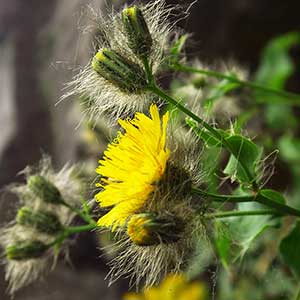Hieracium longiberbe
Hieracium umbellatum
long-bearded hawkweed, longbeard hawkweed
Canada hawkweed, narrow-leaf hawkweed, northern hawkweed, umbellate hawkweed
proximally piloso-hirsute (hairs 2–8+ mm), sometimes glabrate, distally glabrous or piloso-hirsute (hairs 2–5+ mm).
proximally usually glabrous, sometimes piloso-hirsute and/or stellate-pubescent, distally usually glabrous, sometimes stellate-pubescent.
basal 0(–3+), cauline 6–12+;
blades spatulate to oblanceolate, 25–80(–100+) × 8–15(–25+) mm, lengths 3–5 times widths, bases ± cuneate, margins usually entire, rarely denticulate, apices obtuse to acute, abaxial faces piloso-hirsute (hairs 2–5+ mm), adaxial usually piloso-hirsute at margins (hairs 2–5+ mm), rarely glabrous.
basal 0(–2), cauline (5–)8–15(–45+);
blades lance-elliptic to lanceolate, (20–)50–100(–150) × (10–)15–25(–40+) mm, lengths (3–)5–10+ times widths, bases cuneate to rounded or truncate (then sometimes ± clasping), margins usually toothed (to laciniate), denticulate, or entire (often ± revolute, at least distally), apices obtuse to acute, faces glabrous or ± stellate-pubescent, sometimes ± scabrellous (especially at or near distal margins).
usually stellate-pubescent, sometimes piloso-hirsute and/or stipitate-glandular as well, rarely glabrous.
usually stellate-pubescent.
campanulate, 7–10 mm.
campanulate to hemispheric, (8–)9–11+ mm.
12–24+;
corollas yellow, 7–12 mm.
30–80+;
corollas yellow, 10–18 mm.
12–15+, apices ± rounded, abaxial faces piloso-hirsute and stellate-pubescent.
12–21+, apices rounded to acute, abaxial faces usually glabrous, rarely piloso-hirsute and/or stipitate-glandular.
bractlets 9–13+.
bractlets 9–15+.
(3–)6–12+ in corymbiform arrays.
(1–)5–30(–100+) in corymbiform to subumbelliform arrays.
columnar, ca. 3.5 mm;
pappi of 32–40+, white or stramineous bristles in ± 2 series, 5–6 mm.
columnar, 2.5–3.5 mm;
pappi of 50–60+, stramineous to sordid bristles in ± 2 series, 6–7 mm.
Hieracium longiberbe
Hieracium umbellatum
Hieracium longiberbe is known only from along the Columbia River.
(Discussion copyrighted by Flora of North America; reprinted with permission.)
The circumscription of Hieracium umbellatum adopted here is supported by research done by others, especially G. A. Guppy (1978) and E. Lepage (1960). Hieracium canadense var. kalmii (Linnaeus) Scoggan, referable here, is an illegitimate name.
(Discussion copyrighted by Flora of North America; reprinted with permission.)
- Local floras:
BC,
OR,
WA
- Local Web sites:
Flora NW,
Go Botany,
IL Wildflowers,
MI Flora,
MN Wildflowers,
MO Plants,
PNW Herbaria
WildflowerSearch
iNaturalist (observations)
USDA Plants Database
- LBJ Wildflower Center
- SEINet
- Plants of the World Online
- Encyclopedia of Life
- Wikipedia
- Google Image Search


